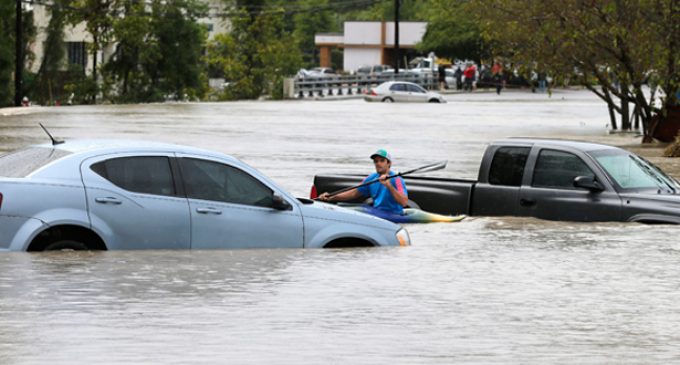‘Fire hose’ of moisture slams South Carolina

By Seanna Adcox And Jeffrey Collins
Associated Press
COLUMBIA, S.C. — People across South Carolina got an object lesson Monday in how you can dodge a hurricane and still get hammered.
Authorities struggled to get water to communities swamped by it, and with waterlogged dams overflowing, bridges collapsing, hundreds of roads inundated and floodwaters rolling down to the coast, the state was anything but done with this disaster.
“This is a Hugo-level event,” said Maj. Gen. Robert Livingston, head of the South Carolina National Guard, referring to the September 1989 hurricane that devastated Charleston. “We didn’t see this level of erosion in Hugo. … This water doesn’t fool around.”
Much-feared Hurricane Joaquin missed the East Coast, but fueled what experts at the National Oceanic and Atmospheric Administration called a “fire hose” of tropical moisture that aimed directly at the state. A solid week of rainfall has killed at least 10 people in South Carolina and two in North Carolina, and sent about 1,000 to shelters. About 40,000 have been left without drinkable water.
One of the latest to die was McArthur Woods, 56, who drove around a barricade and drowned Sunday night. His passenger managed to climb on top of the sedan, which stalled in the rushing water. A firefighter rescued her after someone heard her screams.
“She came out the window. How she got on top of the car and stayed there like she did with that water – there’s a good Lord,” Kershaw County Coroner David West said.
By Monday, the heaviest rains had moved into the mid-Atlantic states. Along the Jersey Shore, some beaches devastated by Superstorm Sandy three years ago lost most of their sand to the wind, rain and high surf.
South Carolina authorities mostly switched Monday from search and rescue into “assessment and recovery mode,” but Gov. Nikki Haley warned citizens to remain careful as a “wave” of water swelled downstream and dams had to be opened to prevent catastrophic failures above low-lying neighborhoods near the capital.
“South Carolina has gone through a storm of historic proportions,” Haley said. “Just because the rain stops, does not mean that we are out of the woods.”
Indeed, shortly after the governor’s news conference, two dams in two separate towns east of downtown Columbia burst on Monday afternoon, forcing the evacuation of some neighborhoods.
James Shirer, who lives in the area, saw one of the dams, in the town of Forest Acres, fail and a 22-acre lake drain in 10 to 15 minutes.
“It just poured out,” Shirer said.
The 16.6 inches of rain that fell at Gills Creek near downtown Columbia on Sunday made for one of the rainiest days recorded at a U.S. weather station in more than 16 years.
An Associated Press reporter surveying the scene by helicopter saw the entire eastern side of the capital city awash in floodwater. Neither trailer parks nor upscale neighborhoods were spared: One mansion’s swimming pool was filled with a yellowish broth.
Some towns were entirely cut off. About 60 miles southeast of the capital, all four roads leading into the county seat of Manning were closed, isolating 4,000 people. Many smaller communities in Clarendon County are in a similar predicament, Sheriff Randy Garrett said.















